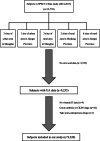Association between serum vitamin D and uric acid in the eastern Chinese population: a population-based cross-sectional study
- PMID: 32493273
- PMCID: PMC7268462
- DOI: 10.1186/s12902-020-00560-1
Association between serum vitamin D and uric acid in the eastern Chinese population: a population-based cross-sectional study
Abstract
Background: Uric acid (UA) is the end product of purine metabolism, which is thought to be related to many human diseases, such as nephrolithiasis, gout, cardiovascular disease (CVD), type 2 diabetes mellitus, metabolic syndrome. However, the relationship between serum UA (SUA) and 25(OH) D is still unclear in the eastern Chinese population.
Methods: We did a population-based observational investigation, which included 12,770 residents living in eastern China. Ultimately, data from 9220 subjects were analyzed. Serum 25(OH) D, SUA, fasting plasma glucose (FPG), fasting insulin, HbA1c and other metabolic parameters were tested. Waist circumference (WC), weight and height were also measured. Questionnaires were collected from these subjects for information on smoking and drinking status.
Results: We enrolled 9220 Chinese adults, including 3681 males (age 55.57 ± 13.23 years) and 5539 females (age 54.31 ± 12.83 years). The levels of SUA were 352.07 ± 79.25 nmol/L and 269.29 ± 64.68 nmol/L in males and females, respectively. The proportion of adults with hyperuricemia (HUA) was 12.26% in the total population. Levels of SUA were positively associated with 25(OH) D, and the incidence of HUA increased 9.4% for every 10 nmol/L increase in 25(OH) D (P < 0.001).
Conclusions: SUA was positively associated with 25(OH) D in the eastern Chinese population. Higher levels of serum 25(OH) D may be a potential predictor of HUA.
Keywords: Hyperuricemia; Public health; Uric acid; Vitamin D.
Conflict of interest statement
The authors declare that they have no competing interests.
Figures
Similar articles
-
Prevalence of hyperuricaemia in an Eastern Chinese population: a cross-sectional study.BMJ Open. 2020 May 20;10(5):e035614. doi: 10.1136/bmjopen-2019-035614. BMJ Open. 2020. PMID: 32439695 Free PMC article.
-
Investigation of vitamin D status and its correlation with insulin resistance in a Chinese population.Public Health Nutr. 2017 Jun;20(9):1602-1608. doi: 10.1017/S1368980017000490. Epub 2017 Apr 5. Public Health Nutr. 2017. PMID: 28376939 Free PMC article.
-
[Association between serum uric acid and fasting plasma glucose in middle and elderly Chinese].Zhonghua Liu Xing Bing Xue Za Zhi. 2014 Oct;35(10):1155-9. Zhonghua Liu Xing Bing Xue Za Zhi. 2014. PMID: 25567025 Chinese.
-
Hyperuricemia research progress in model construction and traditional Chinese medicine interventions.Front Pharmacol. 2024 Mar 7;15:1294755. doi: 10.3389/fphar.2024.1294755. eCollection 2024. Front Pharmacol. 2024. PMID: 38515855 Free PMC article. Review.
-
Uric Acid Metabolic Disorders in Pituitary-Target Gland Axis.Diabetes Metab Syndr Obes. 2024 Feb 7;17:661-673. doi: 10.2147/DMSO.S448547. eCollection 2024. Diabetes Metab Syndr Obes. 2024. PMID: 38343584 Free PMC article. Review.
Cited by
-
Association between serum uric acid levels and peripheral artery disease in Chinese adults with hypertension.Front Endocrinol (Lausanne). 2023 Aug 22;14:1197628. doi: 10.3389/fendo.2023.1197628. eCollection 2023. Front Endocrinol (Lausanne). 2023. PMID: 37674616 Free PMC article.
-
Insulin Resistance and Vitamin D Deficiency: A Link Beyond the Appearances.Front Cardiovasc Med. 2022 Mar 17;9:859793. doi: 10.3389/fcvm.2022.859793. eCollection 2022. Front Cardiovasc Med. 2022. PMID: 35369303 Free PMC article. Review.
-
25-Hydroxyvitamin D Is Associated with Islet Homeostasis in Type-2 Diabetic Patients with Abdominal Obesity.Curr Med Sci. 2023 Oct;43(5):919-926. doi: 10.1007/s11596-023-2780-z. Epub 2023 Sep 12. Curr Med Sci. 2023. PMID: 37697161
-
Prevalence of hyperuricaemia in an Eastern Chinese population: a cross-sectional study.BMJ Open. 2020 May 20;10(5):e035614. doi: 10.1136/bmjopen-2019-035614. BMJ Open. 2020. PMID: 32439695 Free PMC article.
-
The Relationship Between Hemoglobin Glycation Variation Index and Vitamin D in Type 2 Diabetes Mellitus.Diabetes Metab Syndr Obes. 2021 Apr 30;14:1937-1948. doi: 10.2147/DMSO.S310672. eCollection 2021. Diabetes Metab Syndr Obes. 2021. PMID: 33958883 Free PMC article.
References
-
- Skowron K, Pawlicka I, Gil K. The role of vitamin D in the pathogenesis of ocular diseases. Folia Med Cracov. 2018;58(2):103–118. - PubMed
Publication types
MeSH terms
Substances
Grants and funding
- 91857117, 81670717/National Natural Science Foundation of China
- 19140902400, 18410722300/Science and Technology Commission of Shanghai Municipality
- 19XJ11007/School of Medicine, University of Kansas
- 2019-01-07-00-01-E00059/the Major Science and Technology Innovation Program of Shanghai Municipal Education Commission
- PWZxq2017-17/Commission of Health and Family Planning of Pudong District
LinkOut - more resources
Full Text Sources
Medical


